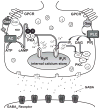Ethanol-enhanced GABA release: a focus on G protein-coupled receptors
- PMID: 20837058
- PMCID: PMC3005894
- DOI: 10.1016/j.brainresrev.2010.09.003
Ethanol-enhanced GABA release: a focus on G protein-coupled receptors
Abstract
While research on the actions of ethanol at the GABAergic synapse has focused on postsynaptic mechanisms, recent data have demonstrated that ethanol also facilitates GABA release from presynaptic terminals in many, but not all, brain regions. The ability of ethanol to increase GABA release can be regulated by different G protein-coupled receptors (GPCRs), such as the cannabinoid-1 receptor, corticotropin-releasing factor 1 receptor, GABA(B) receptor, and the 5-hydroxytryptamine 2C receptor. The intracellular messengers linked to these GPCRs, including the calcium that is released from internal stores, also play a role in ethanol-enhanced GABA release. Hypotheses are proposed to explain how ethanol interacts with the GPCR pathways to increase GABA release and how this interaction contributes to the brain region specificity of ethanol-enhanced GABA release. Defining the mechanism of ethanol-facilitated GABA release will further our understanding of the GABAergic profile of ethanol and increase our knowledge of how GABAergic neurotransmission may contribute to the intoxicating effects of alcohol and to alcohol dependence.
Copyright © 2010 Elsevier B.V. All rights reserved.
Figures


Similar articles
-
A conceptualization of integrated actions of ethanol contributing to its GABAmimetic profile: a commentary.Neuropsychopharmacology. 2005 Aug;30(8):1407-25. doi: 10.1038/sj.npp.1300750. Neuropsychopharmacology. 2005. PMID: 15856077 Review.
-
P/Q-type voltage-gated calcium channels mediate the ethanol and CRF sensitivity of central amygdala GABAergic synapses.Neuropharmacology. 2017 Oct;125:197-206. doi: 10.1016/j.neuropharm.2017.07.017. Epub 2017 Jul 19. Neuropharmacology. 2017. PMID: 28734867 Free PMC article.
-
The PLC/IP 3 R/PKC pathway is required for ethanol-enhanced GABA release.Neuropharmacology. 2010 Jun;58(7):1179-86. doi: 10.1016/j.neuropharm.2010.02.018. Epub 2010 Mar 4. Neuropharmacology. 2010. PMID: 20206640 Free PMC article.
-
The role of protein kinase A in the ethanol-induced increase in spontaneous GABA release onto cerebellar Purkinje neurons.J Neurophysiol. 2008 Dec;100(6):3417-28. doi: 10.1152/jn.90970.2008. Epub 2008 Oct 22. J Neurophysiol. 2008. PMID: 18945815 Free PMC article.
-
The tipsy terminal: presynaptic effects of ethanol.Pharmacol Ther. 2005 Jul;107(1):80-98. doi: 10.1016/j.pharmthera.2005.01.006. Epub 2005 Apr 13. Pharmacol Ther. 2005. PMID: 15963352 Review.
Cited by
-
Rodent models and mechanisms of voluntary binge-like ethanol consumption: Examples, opportunities, and strategies for preclinical research.Prog Neuropsychopharmacol Biol Psychiatry. 2016 Feb 4;65:297-308. doi: 10.1016/j.pnpbp.2015.05.012. Epub 2015 Jun 2. Prog Neuropsychopharmacol Biol Psychiatry. 2016. PMID: 26021391 Free PMC article. Review.
-
Ethanol increases GABAergic transmission and excitability in cerebellar molecular layer interneurons from GAD67-GFP knock-in mice.Alcohol Alcohol. 2012 Jan-Feb;47(1):1-8. doi: 10.1093/alcalc/agr147. Epub 2011 Nov 11. Alcohol Alcohol. 2012. PMID: 22080831 Free PMC article.
-
Ethanol Stimulates Locomotion via a Gαs-Signaling Pathway in IL2 Neurons in Caenorhabditis elegans.Genetics. 2017 Nov;207(3):1023-1039. doi: 10.1534/genetics.117.300119. Epub 2017 Sep 26. Genetics. 2017. PMID: 28951527 Free PMC article.
-
The Cerebellar GABAAR System as a Potential Target for Treating Alcohol Use Disorder.Handb Exp Pharmacol. 2018;248:113-156. doi: 10.1007/164_2018_109. Handb Exp Pharmacol. 2018. PMID: 29736774 Free PMC article.
-
Synaptic effects of ethanol on striatal circuitry: therapeutic implications for dystonia.FEBS J. 2022 Oct;289(19):5834-5849. doi: 10.1111/febs.16106. Epub 2021 Jul 16. FEBS J. 2022. PMID: 34217152 Free PMC article. Review.
References
-
- Addolorato G, Caputo F, Capristo E, Domenicali M, Bernardi M, Janiri L, Agabio R, Colombo G, Gessa GL, Gasbarrini G. Baclofen efficacy in reducing alcohol craving and intake: a preliminary double-blind randomized controlled study. Alcohol Alcohol. 2002;37:504–508. - PubMed
-
- Addolorato G, Leggio L, Ferrulli A, Cardone S, Vonghia L, Mirijello A, Abenavoli L, D’Angelo C, Caputo F, Zambon A, Haber PS, Gasbarrini G. Effectiveness and safety of baclofen for maintenance of alcohol abstinence in alcohol-dependent patients with liver cirrhosis: randomised, double-blind controlled study. Lancet. 2007;370:1915–1922. - PubMed
Publication types
MeSH terms
Substances
Grants and funding
LinkOut - more resources
Full Text Sources

